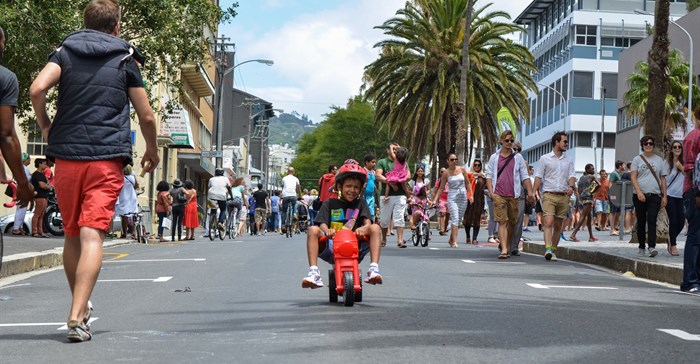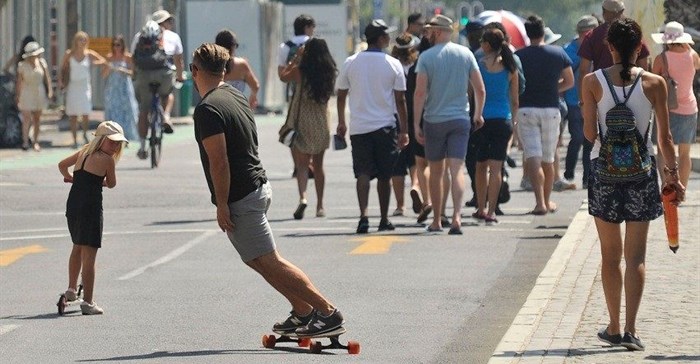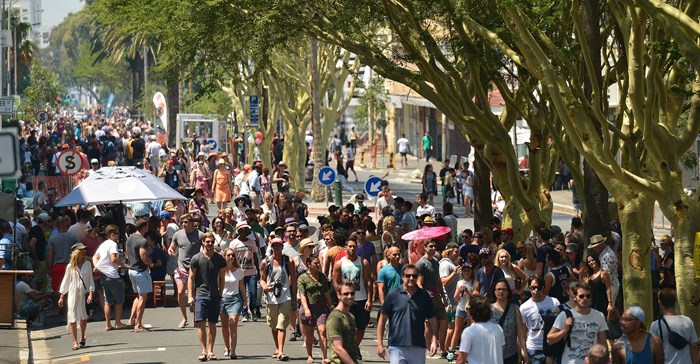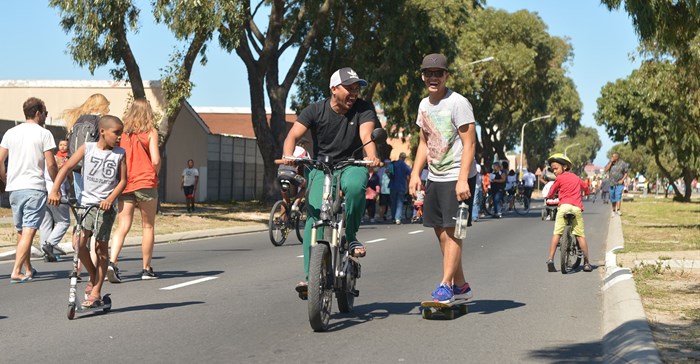If you weren't aware, something is happening in our Mother City. Bicycle lanes are being implemented, people are starting to carpool, walk, skateboard, or roller skate to wherever they need to go. Seriously, I saw a guy roller skating to a bar in Woodstock at 7:15pm the other night. I couldn't believe my eyes.
I recently had a very inspiring conversation with Marcela Guerrero Casas, co-founder and director of Open Streets Cape Town about the power of streets and its ability to bridge social and spatial divides. She also shared what is at the heart of the organisation and how we can collaborate and rethink the use of our streets.
Tell us about Open Streets. How did the idea/initiative come about?
Well, Open Streets is the name of the organisation, and our main programme is Open Streets Days. The reason I make the differentiation is because we’ve grown our portfolio quite extensively over the last couple of years.

Image: Lisa Burnell
To take you back to the beginning, in 2012 a group of us - volunteers, friends, and street enthusiasts - liked the idea of implementing the temporary closure of roads to traffic so that people can use non-motorised transport more effectively - something that has been happening in Latin America for over 40 years now.
I am Colombian by birth and in Colombia where the whole concept started, it happens every Sunday where 120km of streets become car-free. We were inspired by this programme, called Ciclovia. It’s a very large undertaking, it’s a government-run programme, and it’s estimated that more than one million people come out to enjoy the street space every Sunday.
Cape Town had already experienced a car-free festival in 2003/2004 and my understanding is that it was run by the provincial government but it didn’t continue as a programme. Several years later, in 2012 the city of Cape Town got behind the idea again and Open Streets took place in Grassy Park. We built on that interest and have been working with the Transport and Urban Development Authority (TDA) to test and grow the concept.
Since then, Open Streets as an organisation has evolved to look at transport more broadly. We hold the thought that this initiative can help bridge the social and spatial divides in Cape Town. To be honest, that’s our main motivation that brought us all together. You know, we all like the concept of more bicycle-friendly streets, of course, but at the core of what we do is an attempt to help bridge that divide.
Open Streets as a concept is a global movement and more than 400 cities globally are implementing some form of Open Streets Days or programmes. Some have it weekly, others may do it once a year, but it’s all about giving streets back to people instead of cars. So, it’s really something that, as a concept, resonates with people globally.
What is an Open Streets Day all about?
It’s an invitation for people to use, and experience streets differently for a number of hours.
We approached the city from the beginning and they were supportive from the word ‘go’. So, it’s been a joint programme between us and the city of Cape Town. After Grassy Park in 2012, in 2013 we tested the Open Streets Days idea in Observatory and since then we’ve done over 11 Open Streets Days.
The concept, as in Bogota in Colombia, is the same – the temporary closure of streets to traffic so that people can enjoy the streets. That is at its core what the concept is all about.

Image: Bruce Sutherland
Why do you think an initiative such as Open Streets is important in Africa?
I like to think of two main reasons. I don’t know enough about all African cities to know whether this is true for all of them, but as a person who grew up in Latin America and someone who’s been living in South Africa for over 10 years, this idea of bridging the social divide is very important, and streets are a very equalising space. Obviously differences still exist, we can’t pretend that everyone is going to become friends with everybody, however, it is a space where no matter whether you’re cycling on a very expensive bicycle or whether you’re on your cheap roller-skates, you’re using the same space, you’re using the same platform. I think that is a very powerful tool.
From a transport perspective, congestion is a real issue in most cities. Pedestrians are being displaced by the automobile, and public transport doesn’t necessarily work for everybody. There are initiatives like BRT and other innovative developments making inroads. But at the end of the day, there is a lack of respect for pedestrians and for those who use non-motorised transport. I think it’s a very simple way of reminding us that streets occupy a lot of physical space and if we rethought how they were designed and how they were utilised, then we could do more with them.
What do you see as the main challenges and the main opportunities in the transport industry in South Africa?
I think that there’s a real opportunity to reimagine our streets, and in that process to rethink mobility in general. Prioritising the pedestrian is something that sounds really simple, but it’s a real challenge!

Image: Bruce Sutherland
I think that’s not only evident in the way streets are designed, for instance, insufficient sidewalks and bicycle lanes, but also in terms of road injuries and fatalities. South Africa has very scary statistics in that regard. If we reprioritise road uses I think a lot of that could be improved.
Do you foresee expansion in future?
We have very big dreams but until now it’s been small scale. We feel like we’re only scratching the surface. We dream of a big network, something that starts to look a little bit like the Ciclovia in Bogota. Maybe we won’t have 120km but getting closer to a network that allows you to travel throughout the city by means of a bicycle, roller skates, or even walking or running would be phenomenal.
We are in conversation with TDA to see how that can be rolled out. There’s a very big interest from the city. We now need to figure out from a logistics and financial perspective, how it could develop. The hope is to go to every sub-council in Cape Town, it’s a 20-year vision, so we’re taking baby steps.
I personally see Open Streets having a lot of potential for other cities in South Africa. We’ve established a few conversations with similar groups of people in other cities. We see our role as sharing the experience, but it has to come from the ground, in other words, the residents of those cities. It isn’t just about the road closure, it’s about engaging communities. I honestly think that there are people like us in every city around the world and that’s why it’s spreading as fast as it is.

Image: Bruce Sutherland
Some cities have the support of government more than others. We’ve been very fortunate to work so closely with the city of Cape Town. So, it’s all about finding the right partnerships.
How can the public get involved?
Open Streets is a movement and even though I differentiated the organisation from the concept, at the core is a shared set of values. For us, it’s that streets can be more than they currently are. So anyone who feels the same way is invited to touch base with us.
We have a large number of volunteers who help us on Open Streets Days and also more generally. We also have working groups where people interested in shaping where this organisation is going can come together and have various discussions on topics such as low carbon transport for instance.
There is a large number of opportunities where we invite people to get involved: become volunteers, follow us on social media, signing up for our newsletter, literally joining the family.
For more, follow @OpenStreetsCT or go to www.openstreets.org.za.
































